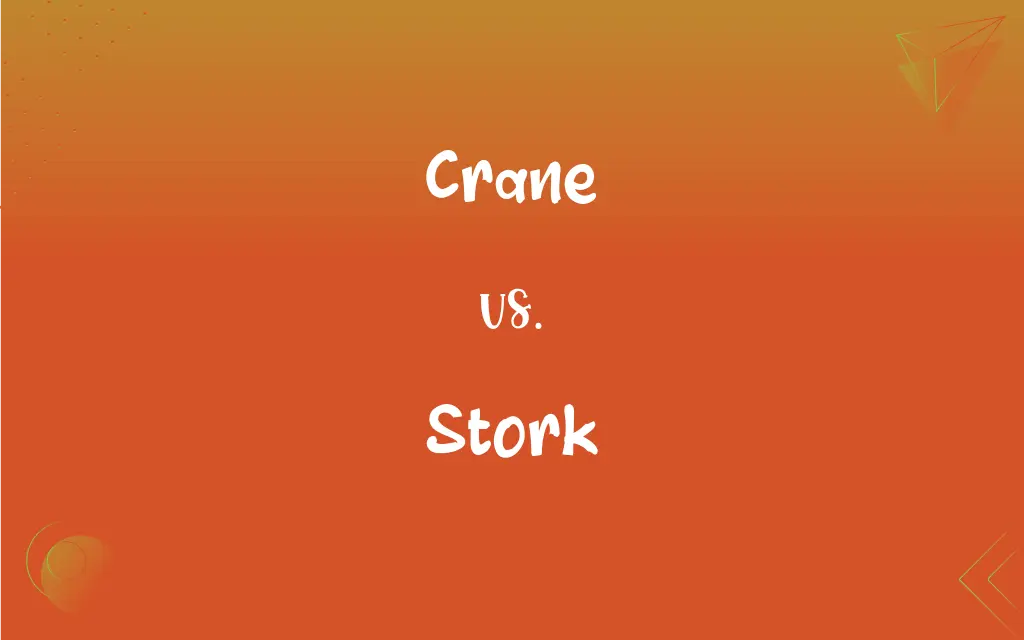Crane vs. Stork: What's the Difference?
Edited by Aimie Carlson || By Harlon Moss || Updated on November 7, 2023
Cranes are a family of tall wading birds with a long neck and bill, while storks belong to a different family of large, long-legged, long-necked wading birds.

Key Differences
Cranes and storks are both large, long-legged and long-necked birds, but they belong to different families; cranes to the family Gruidae and storks to the family Ciconiidae. Cranes are known for their complex mating dances and varied vocalizations, while storks are often silent and are characterized by their habit of clattering their bills.
Cranes are more migratory compared to storks and are often found in a wider range of habitats, from wetlands to grasslands across the globe. Storks tend to be more associated with wetlands and are known to be less migratory, with many species staying in the same area year-round or only moving short distances.
The physical appearance of cranes includes a more streamlined body and, in some species, elaborate plumes on their tails or backs during the breeding season. Storks, on the other hand, have heavier, more robust bodies and lack significant plumage changes during the breeding season. Storks also tend to have slightly shorter tails compared to cranes.
In cultural symbolism, cranes are often associated with luck, longevity, and fidelity in many Asian cultures, while storks have a rich presence in Western folklore, particularly in myths surrounding childbirth. Cranes have also been celebrated in art and literature, signifying various human emotions and ideals.
While both cranes and storks play important roles in their ecosystems, their behaviors and life cycles present notable differences. Cranes can be seen in large flocks, especially during migration, whereas storks are often observed in smaller groups or pairs and are known to be more solitary outside of the breeding season.
ADVERTISEMENT
Comparison Chart
Scientific Family
Gruidae
Ciconiidae
Migration Patterns
Highly migratory
Less migratory, with some species being sedentary
Vocalizations
Varied and often loud
Mostly silent, except for bill clattering
Physical Build
Streamlined body with some species having elaborate plumes
Heavier body, robust build, and shorter tails
Cultural Symbolism
Luck and longevity in Asian cultures
Associated with childbirth in Western folklore
ADVERTISEMENT
Crane and Stork Definitions
Crane
A large wading bird with a long neck and legs, known for its elaborate mating dances.
The crane spread its wings majestically as it prepared to take flight.
Stork
A bird associated with delivering babies in popular mythology.
The children's book depicted a stork bringing a newborn to its parents.
Crane
A machine for lifting and moving heavy objects, often used in construction.
The construction site was busy with the crane hoisting materials to the upper floors.
Stork
A symbol of fidelity and parenting, given their often visible care for their young.
The stork has long been a symbol of parental devotion.
Crane
The act of stretching out one's neck to see something.
She had to crane her neck to see the parade over the crowd.
Stork
Known for nesting on buildings and other structures in some cultures.
In the village, every rooftop had a stork nest on its chimney.
Crane
A tall, mechanical arm used for lifting and moving objects.
The dock workers operated the crane to unload the cargo from the ship.
Stork
Any of the various birds from the family Ciconiidae, often found near water.
A group of storks flew overhead, migrating to their summer breeding grounds.
Crane
To stretch one's body or neck in a particular direction.
He craned forward to catch the whispered conversation.
Stork
A large, long-legged wading bird with a long straight bill.
The stork stood silently by the water's edge, looking for fish.
Crane
Any of various large wading birds of the family Gruidae, having a long neck, long legs, and a long bill.
Stork
(children's folklore) The mythical bringer of babies to families, or good news.
Crane
A similar bird, such as a heron.
Stork
(cartomancy) The seventeenth Lenormand card.
Stork
Any one of several species of large wading birds of the family Ciconidæ, having long legs and a long, pointed bill. They are found both in the Old World and in America, and belong to Ciconia and several allied genera. The European white stork (Ciconia alba) is the best known. It commonly makes its nests on the top of a building, a chimney, a church spire, or a pillar. The black stork (C. nigra) is native of Asia, Africa, and Europe.
Stork
Large mostly Old World wading birds typically having white-and-black plumage
FAQs
Do cranes migrate in flocks?
Yes, cranes often migrate in large flocks to their breeding or wintering grounds.
Why are storks associated with babies?
The myth likely originated from storks nesting on rooftops in Europe, which was seen as a good omen for the family.
Are cranes and storks related?
They are both wading birds but belong to different families.
Are storks really silent birds?
Storks are mostly silent, but they do make clattering sounds with their bills.
What is the significance of cranes in Asian cultures?
Cranes are symbols of luck and longevity in many Asian traditions.
Do cranes dance for a particular reason?
Yes, cranes perform elaborate dances as part of their courtship rituals.
Can both cranes and storks fly?
Yes, both are strong fliers, although cranes are more renowned for their long-distance migrations.
Are all cranes migratory?
Most are, but there are a few resident populations.
Is the whooping crane a type of stork?
No, it is one of the crane species, named for its distinctive whooping call.
Do storks take care of their young?
Yes, both parents typically care for their young.
Are cranes endangered?
Some crane species are endangered due to habitat loss and other environmental pressures.
How tall can cranes and storks grow?
Both can reach notable heights, with some crane species being taller than storks.
How do storks build their nests?
Storks build large nests out of sticks, often on structures like chimneys or poles.
Do storks mate for life?
Many stork species are monogamous and may mate for life.
Do cranes use tools?
Cranes are not known to use tools, but they do use various behaviors to forage for food.
Can the crane's dance be seen outside of mating season?
Sometimes, as cranes can engage in dancing behaviors throughout the year.
What do storks eat?
Storks eat a variety of foods including fish, insects, and small mammals.
Where can you typically find storks?
Storks are commonly found in wetlands, though they adapt to various environments.
Are cranes found all over the world?
Cranes are found on every continent except South America and Antarctica.
How long do storks live?
Storks can live for 20 to 30 years in the wild.
About Author
Written by
Harlon MossHarlon is a seasoned quality moderator and accomplished content writer for Difference Wiki. An alumnus of the prestigious University of California, he earned his degree in Computer Science. Leveraging his academic background, Harlon brings a meticulous and informed perspective to his work, ensuring content accuracy and excellence.
Edited by
Aimie CarlsonAimie Carlson, holding a master's degree in English literature, is a fervent English language enthusiast. She lends her writing talents to Difference Wiki, a prominent website that specializes in comparisons, offering readers insightful analyses that both captivate and inform.































































